Panjiri Recipe
Panjiri is a traditional Punjabi sweet dish made with roasted whole wheat flour (atta), ghee, and a mix of nuts, lightly sweetened with sugar. Commonly prepared during winter and postnatal care, Panjiri is known for its energy-boosting properties and wholesome ingredients, making it a comforting and nourishing treat enjoyed with a spoonful of warmth in every bite.
Panjiri – A Traditional Punjabi Sweet
This panjiri recipe is from my family and is one of the most loved sweets at home. There are many ways of making panjiri, but the version I am sharing today is made only with whole wheat flour.
To prepare it, whole wheat flour is roasted in ghee until golden and aromatic, then mixed with powdered sugar. This simple dry sweet is a winter favorite in Punjabi homes and tastes really good on its own or with warm milk.
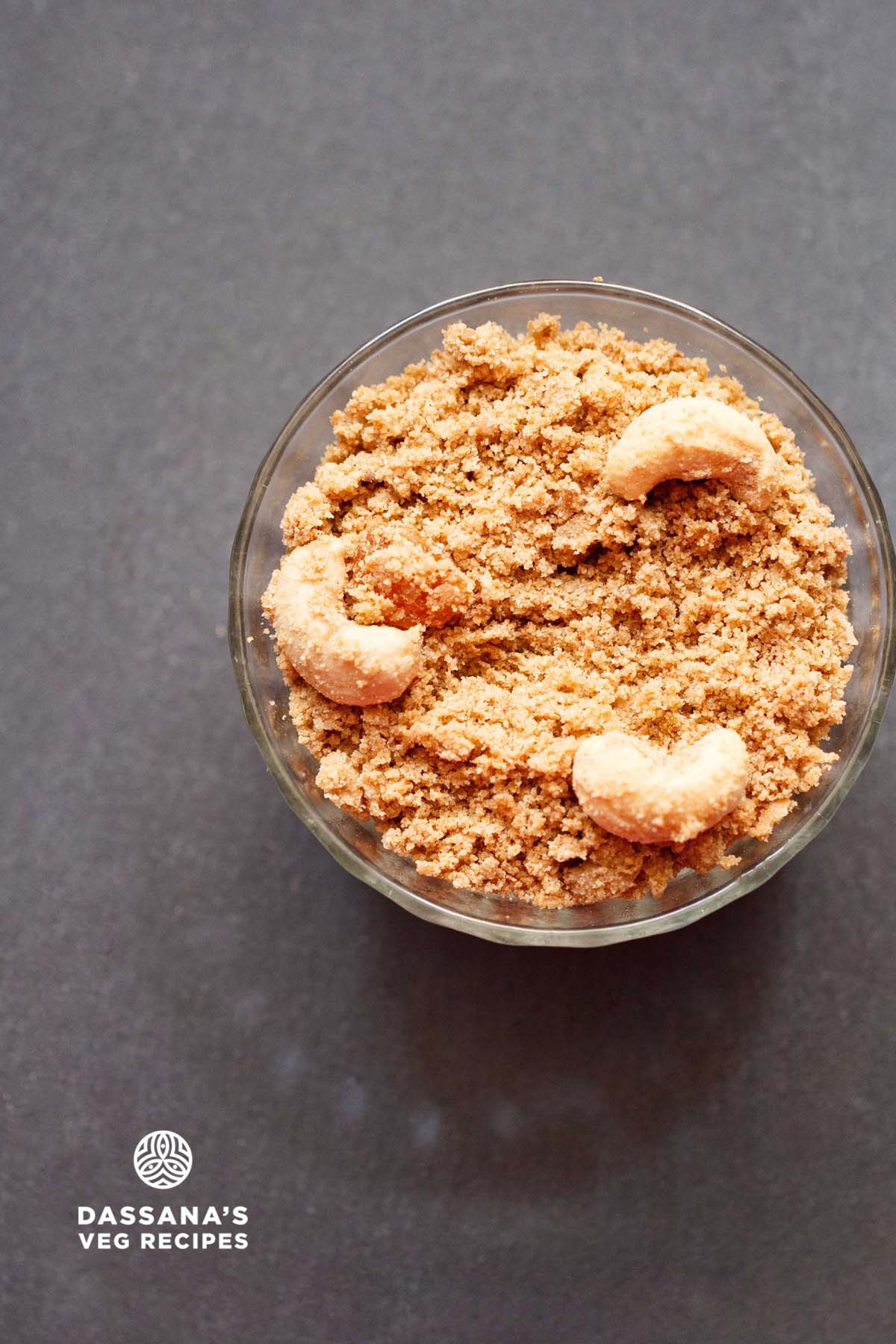
Table of Contents
Panjiri is usually made in winters because it is considered warming for the body. Ingredients like whole wheat flour, ghee, nuts, gond (edible gum), and even jaggery generate heat and provide energy, which helps in keeping the body nourished and strong during the cold season.
That is why panjiri is often given to children, postpartum mothers, and even elders in the family during winter months.
Ingredients & Substitutions
- Sweetener – Traditionally, we use khand or khandsari (raw desi sugar). If you can’t find it, jaggery powder, white sugar powder, or organic unrefined cane sugar work well too. You can also grind regular sugar to a fine powder and use it.
- Flour – This recipe uses only whole wheat flour, but you can make a variation with a 2:1 ratio of wheat flour and sooji (rava).
- Nuts & Dry Fruits – Adding nuts is optional, but I usually do. Cashews and raisins are my go-to choices. Walnuts or pistachios can also be used. For a nut-free version, add seeds like pumpkin seeds, melon seeds (chaar magaz), sesame seeds, or puffed lotus seeds (Makhana).
- Ghee – Desi ghee gives the best flavor. If you are vegan, you can swap with coconut oil or vegan butter.
- Coconut – A bit of roasted desiccated coconut (nariyal ka bura) can be added for more flavor. Roast separately and mix in.
- Gond (Edible Gum) – We usually add gond in winters since it is warming and hearty. Panjiri with gond is also considered good postpartum food. You can also check my recipe of Gond Laddu. Add more nuts and dry fruits if making it for postpartum recovery.
- Spices – For winters, we often add dried ginger (saunth) and gond (edible gum), which are warming and nourishing. Coriander seeds (dhaniya), fennel seeds (saunf), and cardamom (elaichi) are cooling, but when used in small amounts they bring flavor and aroma without reducing the overall warming nature of panjiri.
The recipe can be doubled or tripled easily, just keep in mind roasting time will increase. Panjiri keeps well at room temperature for some weeks. You can make a large batch and store it.
Serve as it is, or with some warm milk. It’s also perfect when you crave something sweet during the day.
How to make Panjiri
Making panjiri at home is simple if you follow the steps carefully. The key is slow roasting so the wheat flour cooks evenly and turns aromatic.
Powder Sugar and Roast Whole Wheat Flour
Start by preparing the sugar and slowly roasting the wheat flour, which are the two main base ingredients for making panjiri.
1. Powder ½ cup sugar in a dry grinder and keep aside. I have used organic unrefined cane sugar. You can also use khand or khandsari which is a desi raw sugar or opt to use white granulated sugar.
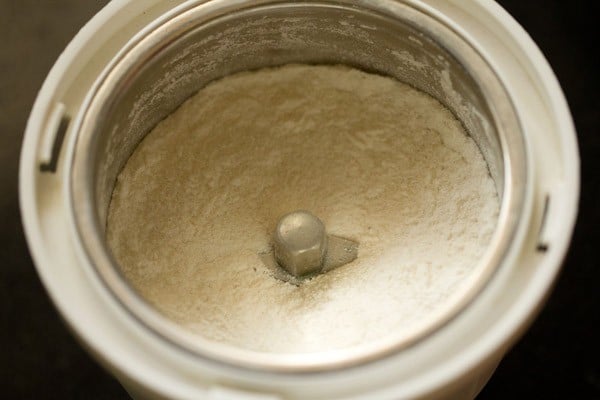
2. Take 1 cup whole wheat flour in a kadai or a thick bottomed broad pan.
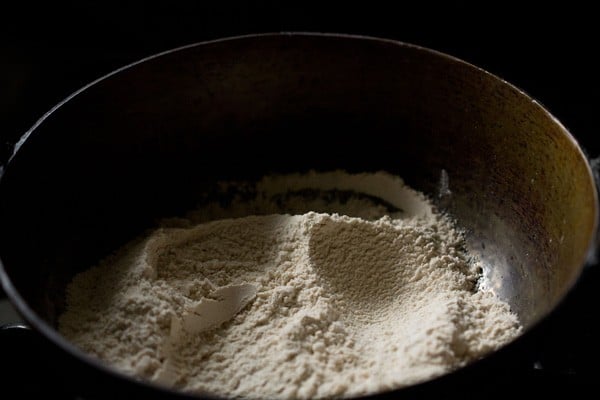
3. Keep the pan on a low flame or sim and begin to roast the whole wheat flour.
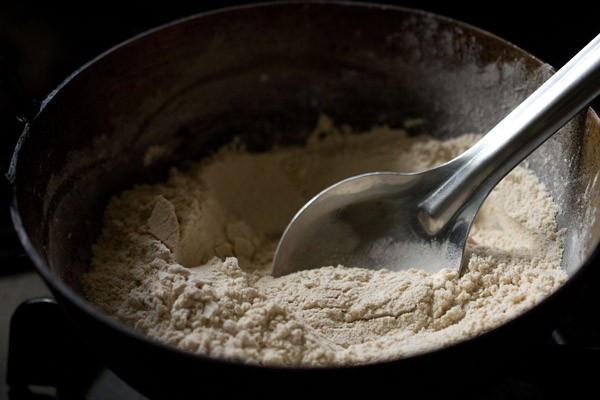
4. You have to stir often while roasting the flour so that there is even roasting and browning.
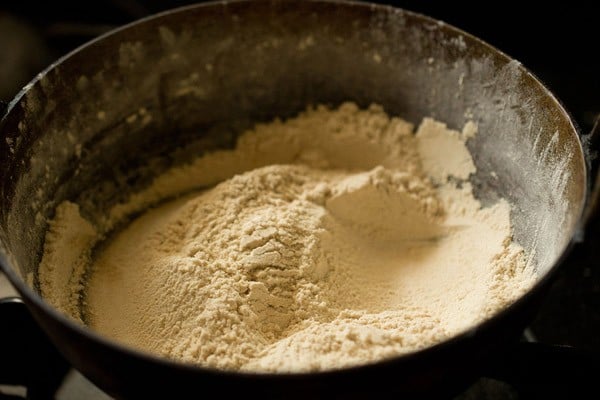
5. Roast till the color changes and you get nutty aroma from the whole wheat flour. This takes about 9 to 12 minutes on a low heat.
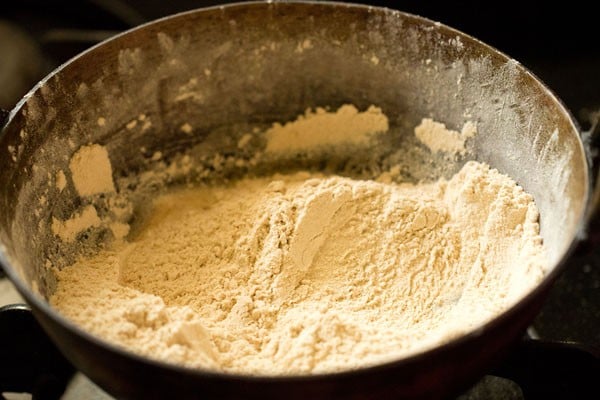
6. Next add 4 tablespoons of desi ghee to the flour.
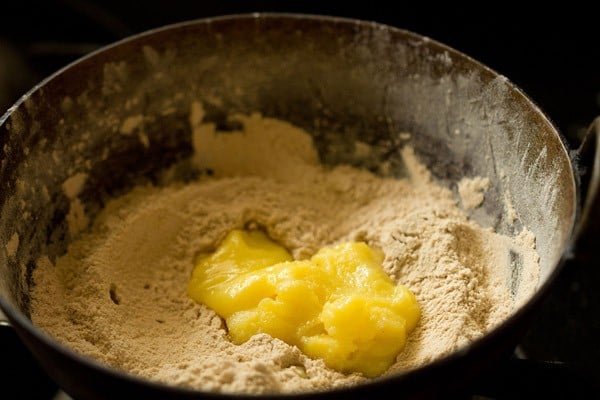
7. Mix very well.
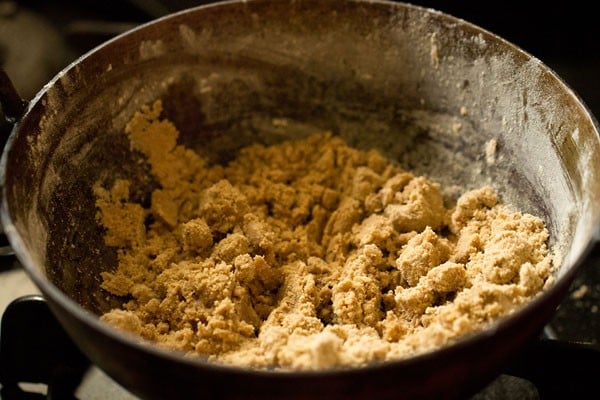
8. Add cashews. If adding almonds, first roast them separately in a pan and then add.
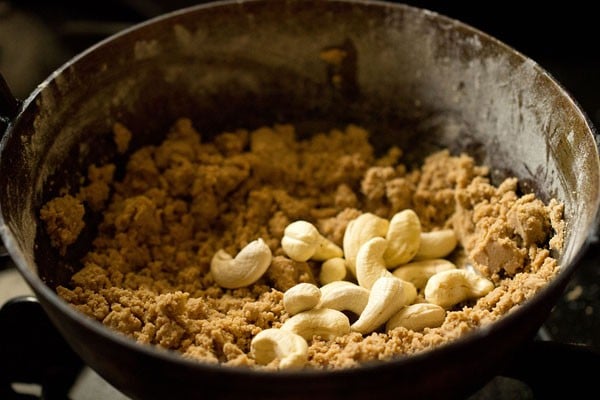
9. Keep on stirring and roasting the panjiri mixture for 5 to 6 minutes more. Do check the taste — the whole wheat flour should taste nutty when cooked properly. There should not even be a slight rawness in the flour.
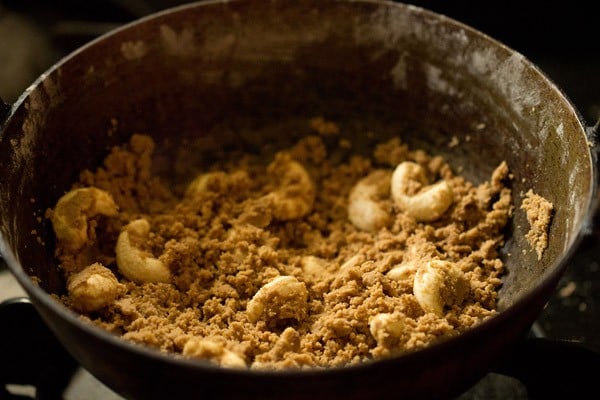
Assemble and Make Panjiri
10. Switch off the heat. Place the pan on the kitchen countertop and add powdered sugar in 2 to 3 batches.
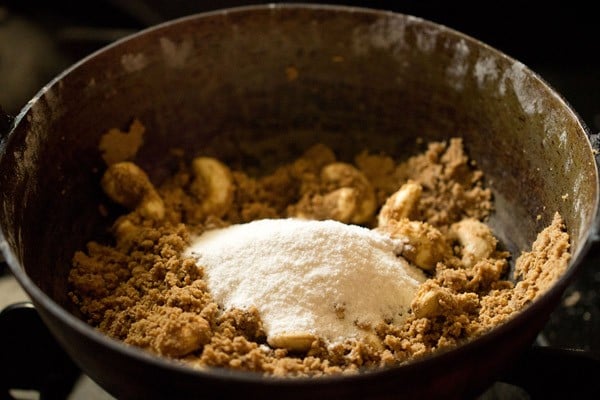
11. Mix very well.
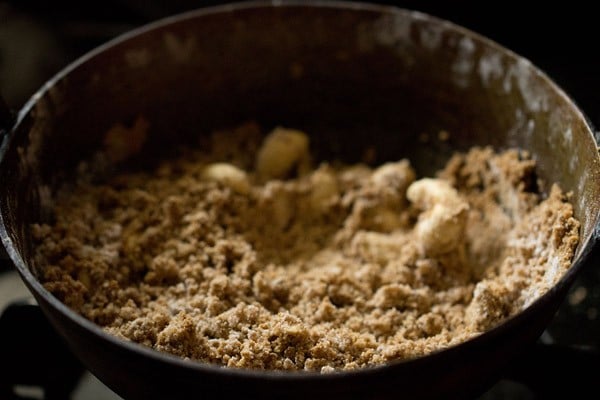
12. Add the remaining amount of powdered sugar.
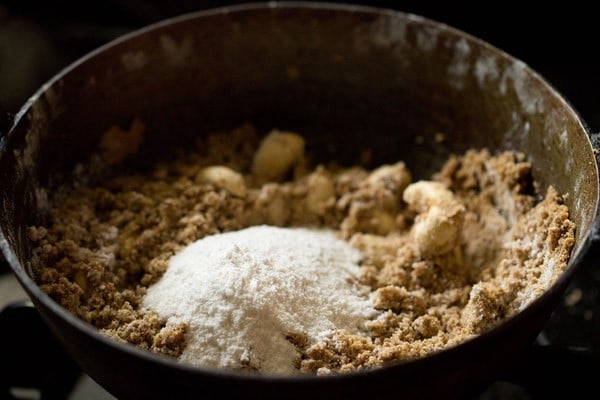
13. Mix the powdered sugar into the roasted flour and nut mixture very well.
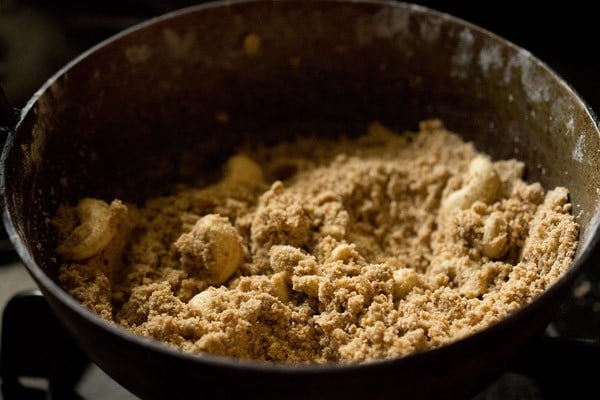
14. Add raisins.
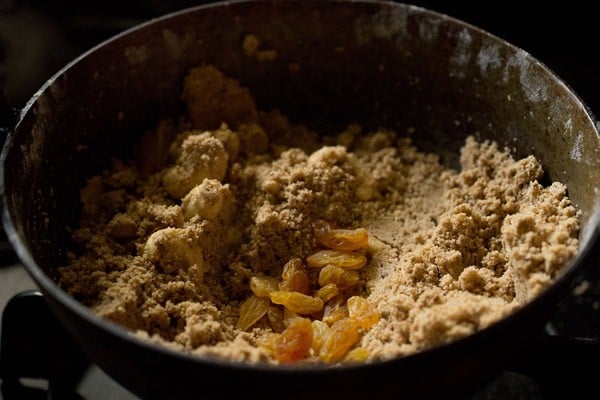
15. Mix again and allow the panjiri to cool.
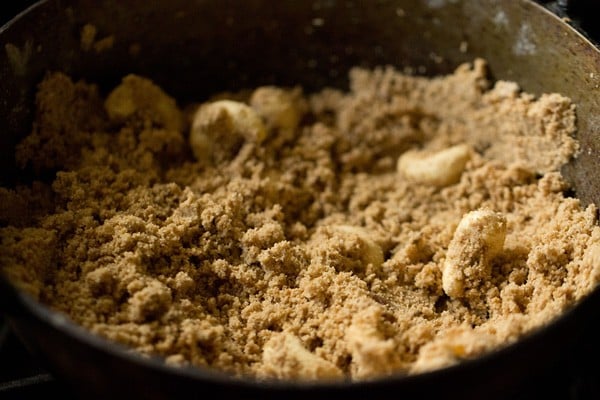
16. Serve Panjiri as is or with some warm milk. Store any leftovers in an airtight jar at room temperature for up to 3 to 4 weeks.
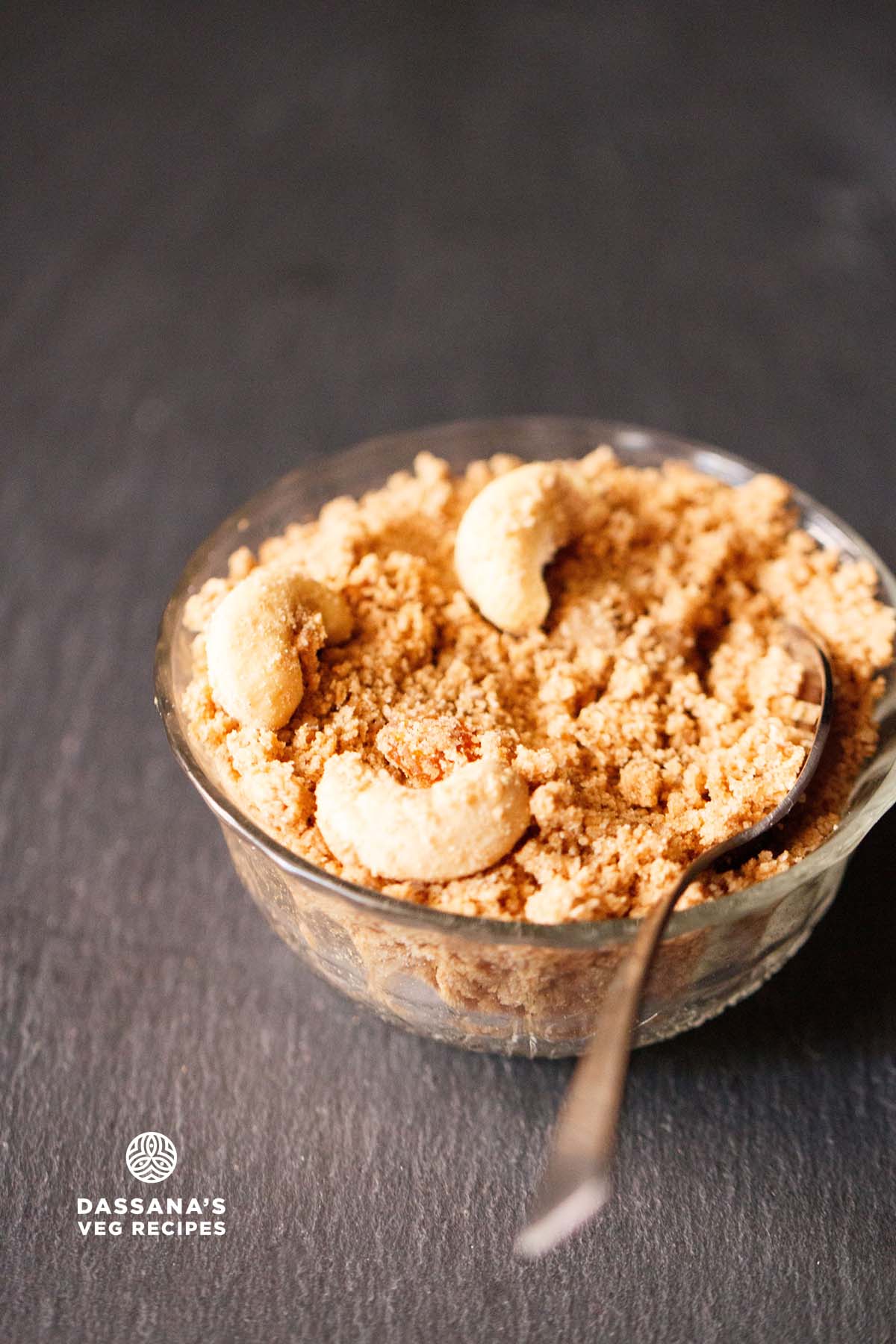
Serving Suggestions
Panjiri is quite versatile and can be enjoyed in different ways. The most common way is to have it plain as a snack or sweet whenever you feel like eating something small.
Many people also like to have it with a glass of warm milk, especially in winters, as it makes the dish more nourishing and filling.
You can even sprinkle a spoonful over halwa, kheer, or porridge to add flavor and texture. It works well as a quick energy snack for kids and elders, and can also be eaten as a light breakfast with milk or tea.
Storage
Since panjiri is a dry sweet, it stays good for some weeks if stored properly. Always let the roasted flour and sugar mixture cool completely before transferring to a container.
Use a clean, dry, airtight steel or glass jar for storage. Keep it in a cool, dry place away from direct sunlight and moisture. Do not refrigerate panjiri as it may harden the texture.
If you are making a large batch, divide it into smaller jars so that you only open one at a time as this helps maintain freshness. When stored well, panjiri keeps its taste and aroma for 3 to 4 weeks at room temperature.
Expert Tips
- Always roast the whole wheat flour on a low to medium heat. Roasting slowly helps the flour cook evenly, develop a nutty aroma, and prevents it from getting raw or burnt.
- Keep stirring continuously while roasting so that the flour does not stick to the pan or form lumps.
- Use a heavy pan or kadai for roasting. A thin pan can cause the flour to brown too quickly or scorch at the bottom.
- The ghee should be just enough to coat the flour grains. Adding too much will make the panjiri greasy.
- If using gond, roast them separately in ghee until they puff up. Once cooled, crush them lightly or powder them before mixing into the roasted flour.
- If adding desiccated coconut, roast it separately for a minute or two until fragrant before combining.
- Add powdered sugar while the roasted flour is still hot so that it mixes in evenly and blends well. If you see small lumps forming, break them up gently with a spoon as you mix.
- This recipe can easily be doubled or tripled, but the roasting time will increase.
FAQs
Can I turn this panjiri into laddoo?
In panjiri, less ghee is added compared to laddu. I suggest warming extra ghee and adding it to the panjiri mixture. Mix well, and then you will be able to shape in ladoo.
Is my panjiri supposed to be dry?
Yes, panjiri is a rather dry and crumbly sweet. Feel free to add more ghee as needed or serve with warm milk if you prefer.
Can we add rava (suji) to this recipe?
Yes! Roast the sooji separately, since sooji gets roasted faster than atta. First roast the sooji in the kadai, till it is nicely fragrant and slightly browned. Remove and keep it aside. Then roast the atta in the same kadai. Now add the roasted sooji back to the pan followed by ghee. Mix very well and proceed with the remaining recipe.
What is the best way to make panjiri for postpartum recovery?
For new mothers, add more dried fruits and nuts for extra nourishment. Including gond (edible gum) is also helpful, as it is warming and is traditionally believed to support lactation.
How long does panjiri last?
If stored in a cool, dark spot in your kitchen in an airtight container, it should keep well for up to 3 to 4 weeks.
More Winter Sweets To Try
Step by Step Photo Guide Above
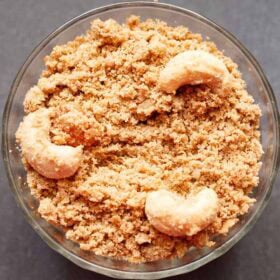
Panjiri Recipe
Ingredients
- 1 cup or (120 grams) whole wheat flour (atta)
- ½ cup or (80 grams) raw sugar or unrefined cane sugar or ½ cup + 1 tablespoon powdered sugar or confectioner's sugar
- 15 to 18 cashews or almonds or a mix of both
- 15 to 18 raisins
- 4 tablespoons desi ghee (clarified butter)
Instructions
- Powder the sugar granules in a dry grinder or mixer-grinder and keep aside.
- Take the whole wheat flour in a kadai or a thick bottomed broad pan.
- Keep the pan on a low heat or sim and begin to roast the whole wheat flour.
- You have to stir often while roasting the flour so that there is even roasting.
- Roast till the color changes and you get nutty aroma from the whole wheat flour. About 9 to 12 minutes on a low heat.
- Once the flour is roasted well add ghee and mix thoroughly.
- Add cashews. If adding almonds, then roast them separately in a pan and then add.
- Keep on stirring and roasting the panjiri mixture for 5 to 6 minutes more. Do check the taste of the whole wheat flour and it should feel cooked. There should be no rawness in the taste.
- Turn off the heat. Place the pan or kadai on the kitchen countertop and add the powdered sugar.
- Mix again very well. Add raisins and mix again.
- Allow the panjiri to cool. Then store in an air tight box and serve panjiri.
Serving Suggestions
- Enjoy panjiri plain as a snack or sweet.
- Serve with a glass of warm milk for a nourishing meal. Sprinkle over kheer, porridge, or halwa for added flavor.
Storage Tips
- Store in a clean, airtight steel or glass jar. Keep in a cool, dry place away from moisture. It stays good at room temperature for 3 to 4 weeks.
Notes
- Roast wheat flour on low to medium heat, stirring non-stop, until golden and aromatic.
- Always use a heavy-bottom pan or kadai to avoid uneven cooking or burning.
- The flour is ready when it turns golden, gives off a nutty aroma, and ghee begins to release from the sides.
- Add powdered sugar when the roasted flour is still hot or warm, so it mixes evenly.
- If needed, adjust the amount of ghee carefully as too little makes panjiri dry, too much makes it greasy.
- Add nuts, seeds, preferred spices or a bit of roasted coconut for extra flavor and nutrition.
Nutrition
Panjiri recipe from the blog archives was first published on June 2015.

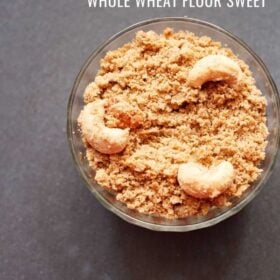
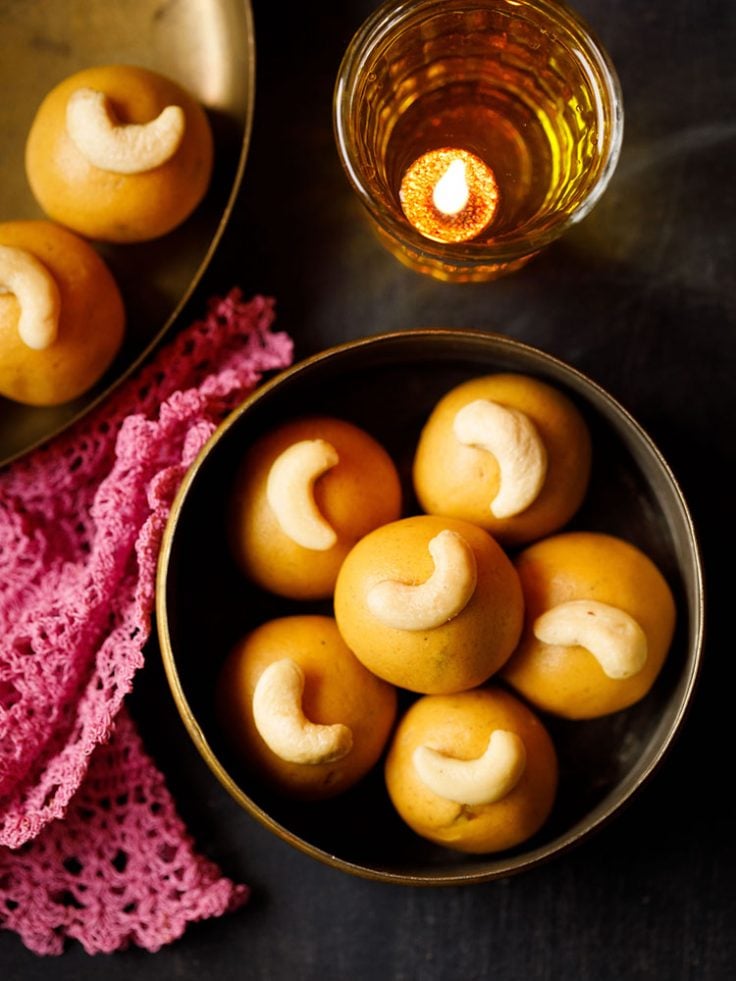
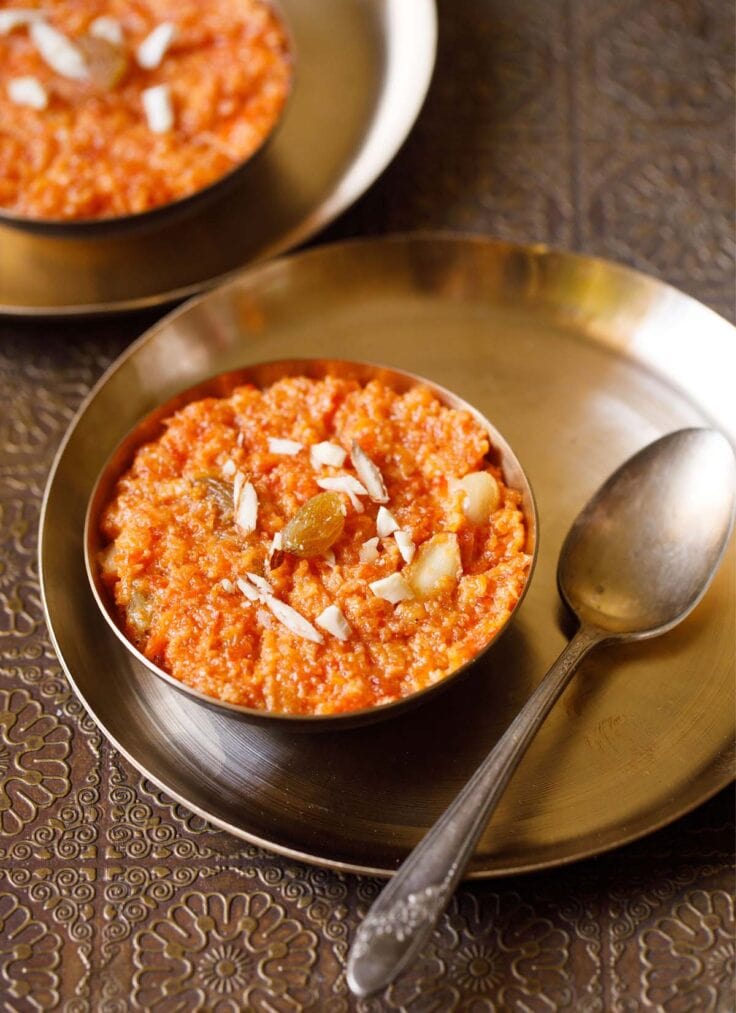
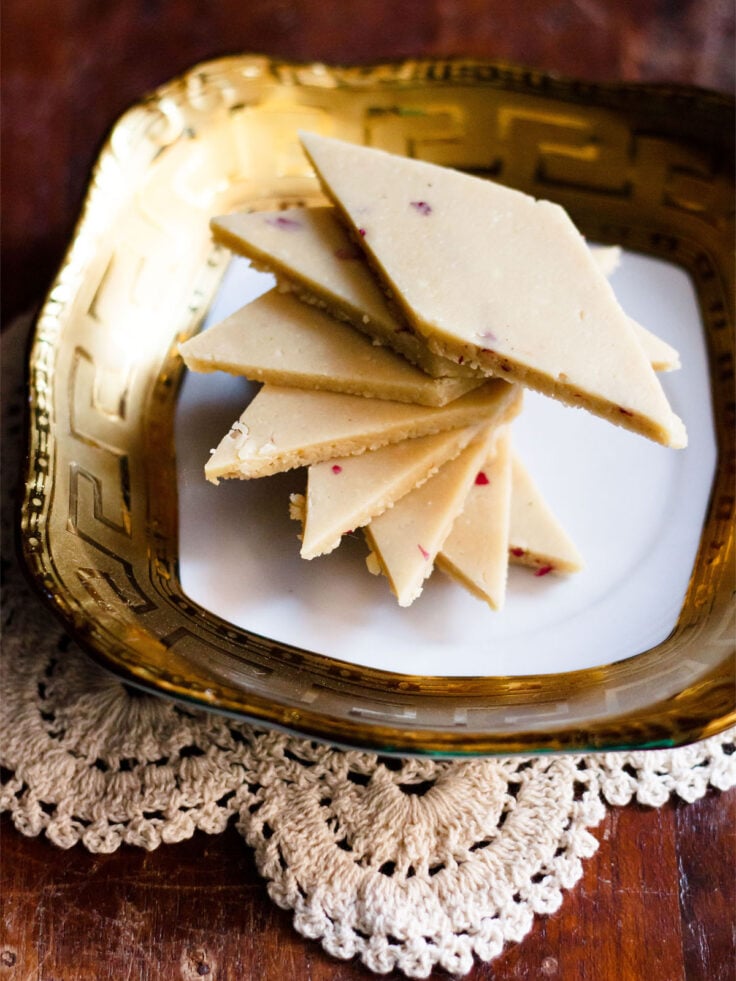
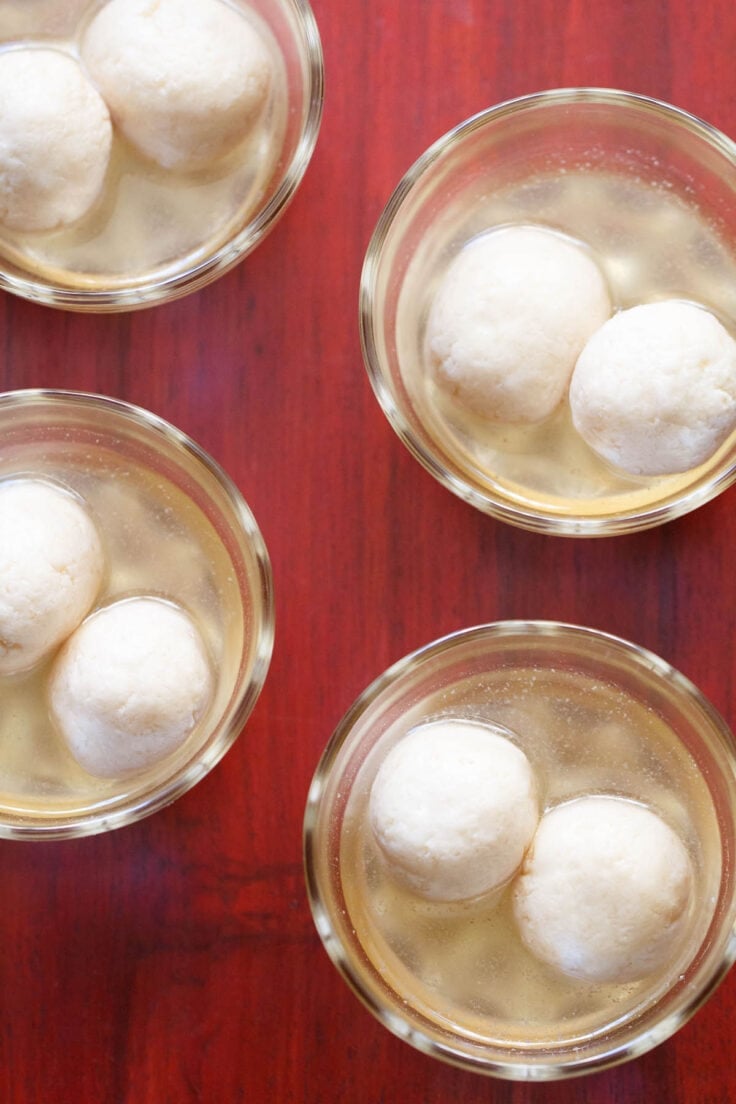
Thank You!
You’re welcome!
Superb recipe, so simple. I made it for postpartum recovery and it turned out perfectly. I added more ghee, roasted nuts (walnuts, almonds, cashews) and added more ghee roasted raisins too as I didn’t have edible gum.
I waited for it to cool and coarse ground the whole mixture which gave it a really nice texture (like broken atta pinnis). I love your blog and the step by step recipes. I always turn to your blog first for any veg recipes 🙂
Lovely and thanks so much for this detailed feedback on the recipe. Thanks again.
Yummy….Superb…Also share the recipe for diabetic…Thanks.
You could use dried dates powder or a diabetic friendly natural sweetener.
Hii
I have made panjari it came out v. Delicious but I wanted to bind it into ladoo while it was still warm but I don’t know why ladoo’s are not holding together.
thanks. in panjiri less ghee is added as compared to laddu. so i would suggest to warm ghee and add in the panjiri mixture. mix and then you will be able to shape in ladoo.
Hello Dassana!
I made atta ka halwa with you recipe and it was great! I am not a good cook, but following your step my halwa was turned so good.
Thank you!
Welcome Kamal. Glad to know that atta ka halwa turned out good.
Hi Dassana,
Thank you for your fantastic recipes. I have tried many dishes from your website and the whole family enjoy them. I made the panjiri yesterday but I think the ghee I added was not enough, as the panjiri is quite dry. Is there anything I can do to fix this? Please help
Thank you
welcome ria. panjiri is dry. you can still melt some ghee and add to the panjiri and just mix it well.
In tried this recipe and it came out brilliantly! So simple and hearty. I always come to your website whenever I’m looking for a recipe. I just don’t bother with the others because your website layout is simple, step by step with pictures so I know I’m going in the right direction when trying out something. Thanks so much for your efforts and for what you do .. keep it up!
thank you nishtha. it does help when readers mention about the layout and step by step pics. i also feel i am going in the right direction ????
thanks again.
very nice recipes .When i am watching your images i am feeling real smell of your recipes. Thanks for showing nice & original recipes. Visit my site too.
thanks pranita. also nice to know you have a website too. i have removed the link as then the comment goes in spam. all the best for your website.
Hi,
I tried most of your receipes, and all came out very well. Thanks for sharing different varities of food, and food from different parts of India. whenever i want to try something new or dont know what exactly to prepare i just go through your site. Thanks once again. 🙂
welcome jagruthi. glad to know this. thanks for your encouraging feedback.
how u add rawa suji in this pinjiri ?at what step do we add suji in it?
roast the sooji separately, since sooji gets roasted faster than atta. first roast sooji in the kadai, till its nicely fragrant and slightly browned. remove and keep it aside. then roast atta in the same kadai. then add the roasted sooji, followed by ghee. mix very well and proceed with the remaining recipe.
Nice recipe i must try thanks dassana
surely try Ashley and let us know how it was? and you are welcome.
Hi
wonderful receipie for kids !!!!!! nice !!!Thank you!!!!!!!!!!!!
thankyou gopika 🙂
Hi Dasanna,
You have an awesome food blog here with a vast recipe collection. I tried out this panjiri recipe for my toddler today & she loved it. Thanks for a great step by step explanation. Planning to try out some more of your recipes for this diwali.
thankyou so much akshatha do try recipes and let us know how they were? and you are welcome.
Hiii.. Dassana ur blog is just fantastic.. .. Ur receipes r soo good.
I keep trying making new food browsing ur website n most of the time.it turns out well
Thanku so much .. U inspire me a lot for tryng different foods..
thankyou sangeeta for your positive and encouraging words 🙂 also pleased to know you liked the recipes you tried. looking forward for more feedback from you keep cooking and experimenting.
Cud i get a recipe of panjiri made specially for those who hv just given birth. For them to regain their health their panjiri ingredients are a bit different. Tq.
we make panjiri with gond or edible gum, wheat flour and dry fruits. but i have not added the recipe on the website. you can have a look at the web and see if you can get a gond panjiri recipe.
Nice
Came out really tasty. Thanks a lot from making the recipe steps easy & simple.
thanks pushpa.
Hi Dassana, i remebere having this panjiri as kid where the punjabis gave this as prasad …. I did try this today … but after adding the ghee the whole mixture was not dry like how it is in the above pic… it was little bit wet and soft … can you tell me where i went wrong… and yes i think i over raoasted the wheat beacause it was dark brown in colour …
thanks in advance and regards
marina ..
it depends on the quality of ghee. even if it becomes soft, no problem. some softness is also fine. in fact if very soft, then they can be shaped and what you get is pinni. similar to ladoos.
i love the sound of this. will surely try one of these days.
Thanks for this recipe. It looks good and i hope to try it as I am keen to try many of your recipes.
Dassana ,you are doing full justice to our cuisine and anyone searching for veg recipes of india will not be disappointed. Hats off to you!
welcome lata. thanks for your kind words. i am touched.
just the other day my cousin mentioned she was making panjiri.. i was instantly reminded of my childhood, and now here i am all set to try it out myself
Thanks for this
Recipe with step by step pic its gv us right direction to see and learn how to make delicious
thank priyanka.
Hi….your all recipies are too gud…
I am a big fan of urs..
Plz post some recipes of puddings
thanks you ruchika. i do plan to add some pudding recipes.
dear dassana,
I love your webpage and have tried lot of recipes succesfully. but in your revised webpage, whenever i want a particular recipe i need to search in google, which in return gives your webpage link. could you please add search link please.
hi preethu, search tab is already there on all pages. right at the top below the navigation menu.
Hi dassana,
Sorry this is doubt regarding your aloo tikki burger recipe, i found comments were closed in that post, so commenting here. My son loved it and he wants it for his tiffin box and it is difficult for me to prepare in the mornings, can the tikkis can be frozen and reheated ?
no issues. don’t fry and then freeze and then reheat. just make the tikkis and freeze. then you can fry them in the mornings.
Hi Dassana,
I love all your recipes.
Punjabi Pranji looks great and yummy.
What is the shelf life of this dish ?
thanks,
Vani S
welcome vani. it can stay good for more than 2 months at room temperature.
Quite a healthy recipe:) Its a good idea to add ghee after roasting the atta, makes it a guiltfree sweet to gorge on.
I need to say a big thanks to you dear for this website. I religiously follow your recipes to the ‘T’, there were a few occasions when I missed some steps and the outcome was not that great. Really appreciate the step by step guide.
Thank you again and God bless
thanks a lot supriya. adding ghee later is better as when ghee is added first, then its a lot of hand work to stir the mixture as with ghee the mixture becomes somewhat heavy to stir.
Didn’t able to find comment section on “Dal makhni Restaurant style” recipes page, so posting review for that here.. Sorry for this. Well about the recipe all I can say is that was THE BEST DAL EVER MADE IN MY HOME… Thanks a lot Dassana & Amit. Lots of love. @aditiespeaks
no problem aditi. thanks a lot for this awesome feedback on the restaurant style dal makhani recipe.